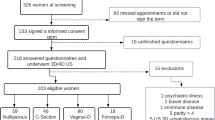Abstract
Objective
The aim of the study is to analyse urethral mobility and excursion of the pubo-rectal angle, using perineal ultrasound, after normal vaginal delivery and water delivery.
Materials and methods
A total of 52 primiparous women were enrolled: 25 who had delivery in water (W Group), 27 who had delivery without using water (NW Group). Every woman underwent perineal ultrasound assessment at 6 months after having given birth. The following parameters were assessed: urethral mobility during Valsalva’s manoeuvre, movement of the pubo-rectal sling angle during contraction of the levator ani muscle.
Results
Data obtained show that the urethral mobility during Valsalva’s manoeuvre is higher in the W Group (34.9°) in comparison to the NW Group (29.5°), without statistically significant differences. The excursion of the pubo-rectal sling angle resulted lower in the W Group (8.7°) than in the NW Group (11.0°), without statistically significant differences.
Conclusion
The present study found no statistically differences in pelvic floor, using perineal ultrasound, between water and “non-water” delivery.




Similar content being viewed by others
References
Weber AM, Buchsbaum GM, Chen B, Clark AL, Damaser MS, Daneshgari F, Davius G, De Lancey J, Kenton K, Weidner AC, Word RA (2004) Basic science and traslational research in female pelvic floor disorders: proceedings of an NIH-Sponsored Meeting. Neurol Urodyn 23:288–301
O’Boyle AL, O’Boyle JD, Calhoun B, Davis GD (2005) Pelvic organ support in pregnancy and postpartum. Int Urogynecol J Pelvic Floor Dysfunct 16(1):69–72
Marshall K, Walsh DM, Baxter GD (2002) The effect of a first vaginal delivery on the integrity of the pelvic floor musculature. Clin Rehabil 16(7):795–799
Costantini S, Esposito F, Nadalini C, Lijoi D, Morano S, Lantieri P, Mistrangelo E (2004) Ultrasound imaging of female perineum: the effect of vaginal delivery on pelvic floor dynamics. Ultrasound Obstet Gynecol 23:298–301
Lal M, H Mann C, Callender R, Radley S (2003) Does cesarean delivery prevent anal incontinence? Obstet Gynecol 101(2):305–412
Rortveit G, Daltveit Ak, Hannestad YS et al (2003) Urinary incontinence after vaginal delivery or cesarian section. N England J Med 348:900–907
Ochsenbein N, Kurmanavicius J, Huch R, Huch A, Wisser J (2001) Pelvic floor in nulliparous women and after elective cesarean section. Acta Obstet Gynecol Scandinavica 80:611–615
Nygaard I (2005) Should women be offered elective caesarean section in the hope of preserving pelvic floor function? Int Urogynecol J 16:253–254
Sartore A, De Seta F, Maso G, Pregazzi R, Grimaldi E Guaschino S (2004) The effect of mediolateral episiotomy on pelvic floor function after vaginal delivery. Obstet Gynecol 103:669–673
MacLennan AH, Taylor AW, Wilson DH, Wilson D (2003) The prevalence of pelvic floor disorders and their relationship to gender, age, parity and mode of delivery. BJOG 110(1):88
Meyer S, Hohlfeld P, Achtari C, Russolo A, De Grandi P (2000) Birth trauma: short and long term effects of forceps delivery compared with spontaneous delivery on various pelvic floor parameters. BJOG 107(11):1360–1365
Peschers UM, Sultan AH, Jundt K, Mayer A, Drinovac V, Dimpfl T (2003) Urinary and anal incontinence after vacuum delivery. Eur J Obstet Gynecol Reprod Biol 110(1):39–42
Peschers UM, Schaer GN, DeLancey JO, Schuessler B (1997) Levator ani function before and after childbirth. Br J Obstet Gynaecol 104(9):1004–1008
Lee SJ, Park JW (2000) Follow-up evaluation of the effect of vaginal delivery on the pelvic floor. Dis Colon Rectum 43(11):1550–1555
Alderice F, Renfrew M, Marchant S, et al (1995) Labour and birth in water in England and Wales: Survey report. Br J Midwifery 3:375–382
Bodner K, Bodner-Adler B, Wierrani F, Mayerhofer K, Fousek C, Niedermayr A, Grunberger W (2002) Effects of water birth on maternal and neonatal outcomes. Wien Klin Wochenschr 114(10–11):391–395
Cluett ER, Nikodem VC, McCandlish RE, Burns EE (2004) Immersion in water in pregnancy, labour and birth. Cochrane Database Syst Rev 2:CD000111
Otigbah CM, Dhanjal MK, Harmsworth G, Chard T (2000) A retrospective comparison of water births and conventional vaginal deliveries. Eur J Obstet Gynecol Reprod Biol 91(1):15–20
Sampselle CM, Brink CA, Wells TJ (1989) Digital measurement of pelvic muscle strength in childbearing women. Nurs Res 38:134–138
Brink CA, Wells TJ, Sampselle CM, Taillie ER, Mayer R (1994) A digital test for pelvic muscle strength in women with urinary incontinence. Nurs Res 43:256–352
Costantini S, Mistrangelo E, Francioso R, Valenzano Menada M, Risso D, Lantieri P (2005) Vaginal versus transabdominal hysterectomy: is mode of hysterectomy to influence pelvic statics or is pelvic statics to influence mode of hysterectomy? Acta Obstet Gynecol Scand 84(4):376–379
Garland D, Jones (2000) Waterbirth: supporting practice with clinical audit. MIDIRS Midwifery Digest 10(3):333–336
Burns E (2001) Waterbirths. MIDIRS Midwifery Digest 11(3):S10–S13
Author information
Authors and Affiliations
Corresponding author
Rights and permissions
About this article
Cite this article
Mistrangelo, E., Gaggero, C., Nadalini, C. et al. Does water delivery affect pelvic floor? Ultrasound evaluation of perineal function. Arch Gynecol Obstet 276, 133–138 (2007). https://doi.org/10.1007/s00404-007-0322-8
Received:
Accepted:
Published:
Issue Date:
DOI: https://doi.org/10.1007/s00404-007-0322-8




